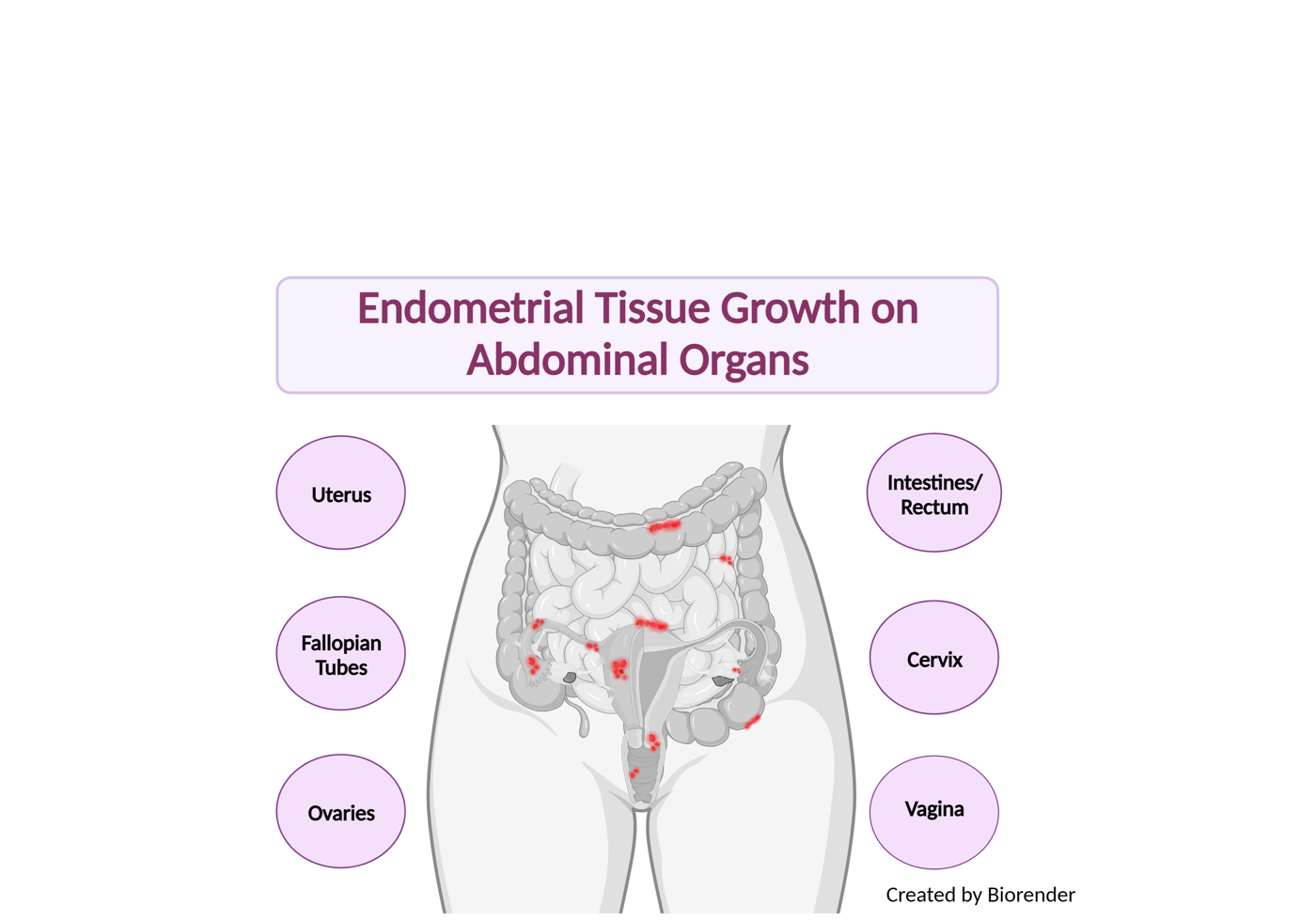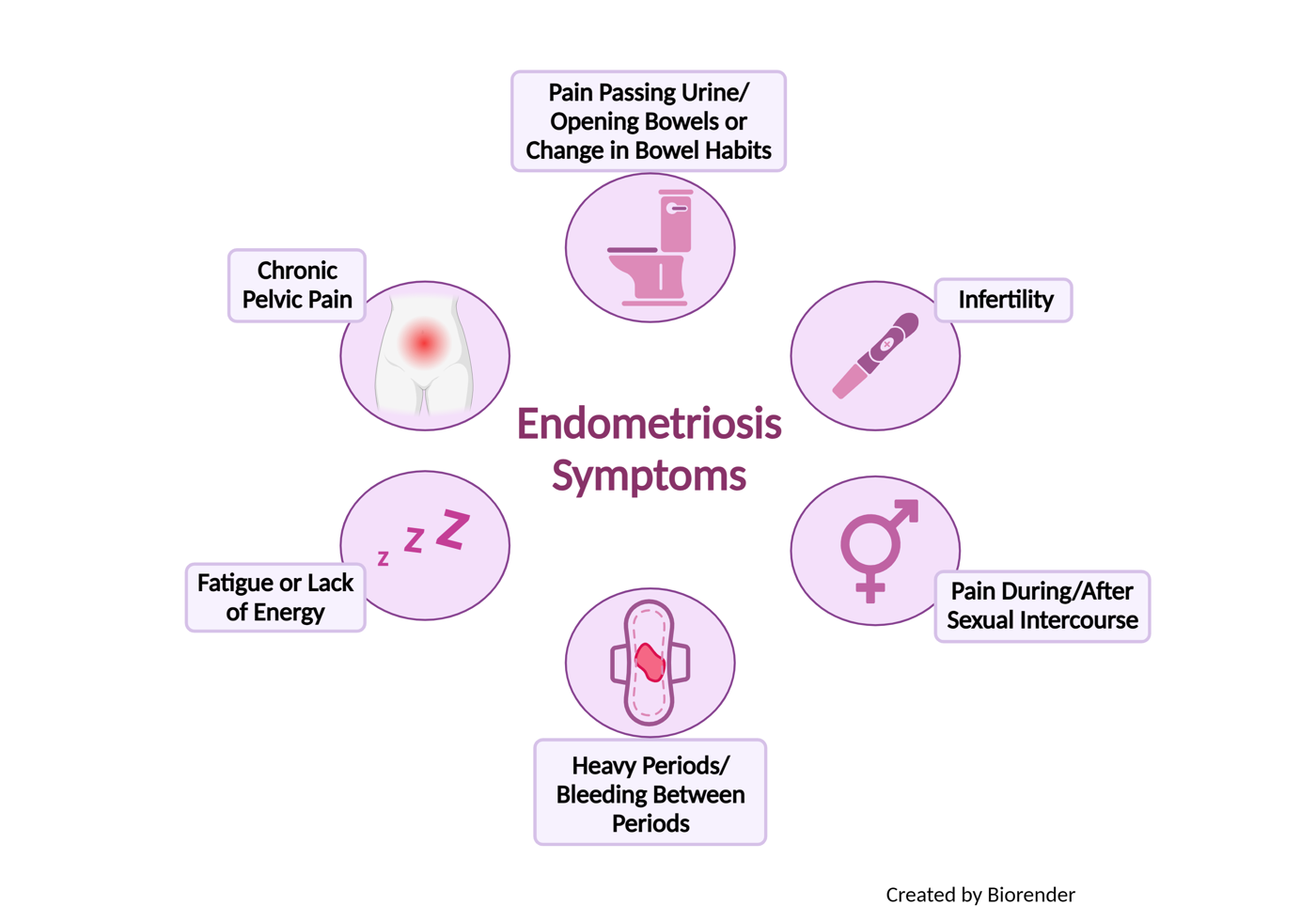What is endometriosis?

In endometriosis, the tissue that normally covers the inside of the womb (the endometrium) grows outside of it, usually on neighbouring organs in the lower abdomen. The endometrium is a special type of tissue that responds to the monthly cycle of female hormones by shedding during a woman’s period then regrowing in time for the next cycle. In endometriosis, this tissue continues to function outside of the womb in the same way it did whilst in the uterus, it thickens and then sheds away inside the abdomen every month during each menstrual period. This, in turn, can be very painful, causes local irritation, and eventually the development of scar tissue where adhesions (abnormal tissue which makes internal organs stick together) can develop.
What causes endometriosis?
Researchers are not absolutely certain what causes endometriosis and there are many theories that try to answer this question.
One of the most popular theories is ‘retrograde menstruation’ when menstrual blood, containing endometrial cells, flows back through the fallopian tubes into the pelvis and abdomen rather than being expelled through the vagina. Most women will get some retrograde bleeding; however, only some develop endometriosis when the endometrial cells do not die but continue to function and grow outside the womb. Current research is trying to uncover the details of this process, as well as investigating other theories with a view to developing more effective treatments and diagnostic tests. Such theories include development of endometriosis on the outside of the ovary (endometrioma) due to unusual stem cell proliferation.
What are the signs and symptoms of endometriosis?

The most typical symptom of endometriosis is pain associated with the onset of the period, which usually affects the lower back, abdomen and pelvic area. This is often at its worst one week before the period starts. Cramp-like pain during monthly periods is common for many women but those suffering from endometriosis complain of far more severe symptoms. Another important feature of this condition is that the amount of pain a woman experiences does not correspond to how much endometrial tissue is present outside the womb. In women with very severe endometriosis, because there is scarring of the nerve endings, there may be minimal symptoms. On the other hand, women with very early endometriosis can have debilitating pain.
Other symptoms of endometriosis include:
- pain during or after sexual intercourse
- chronic pelvic pain
- infertility – endometriosis is often diagnosed during investigations for fertility problems
- pain when opening the bowels or passing urine (usually during the monthly period)
- heavy periods or bleeding between periods
- women may also experience change in their bowel habits and bloating especially during their period. There is a strong connection between endometriosis and irritable bowel syndrome
- fatigue/lack of energy and depression.
How common is endometriosis?
Endometriosis primarily affects women of childbearing age, although girls and post-menopausal women can also be affected. Although extremely rare, some men can also be affected. In women, it is a very common condition and although its exact prevalence is difficult to estimate, it is thought to affect about 10% of women worldwide. Endometriosis affects approximately two million women in the UK. It is generally recognised that endometriosis is much more common in women who have difficulty conceiving and in women with chronic pelvic pain.
Is endometriosis inherited?
Endometriosis is not thought to be an inherited condition but according to some recent epidemiological studies, some women have a genetic predisposition to developing endometriosis.
How is endometriosis diagnosed?
The initial but most important step in the diagnosis of endometriosis is a detailed history of the symptoms experienced. A vaginal examination will often help to determine areas of tenderness in the pelvis and indicate to your doctor the potential extent of the disease.
Another useful and common test that can help to diagnose endometriosis is an ultrasound scan. A probe is inserted into the vagina and sound waves are used to depict the neighbouring organs.
The definitive technique for diagnosing endometriosis is called an abdominal laparoscopy. This is a keyhole operation performed under general anaesthesia. A telescope camera is passed through the navel into the abdominal cavity allowing doctors to directly visualise the pelvic area and identify the exact location and extent of endometriosis. At the same time they can take pictures or videos and plan treatment accordingly.
In certain advanced cases, another imaging test used is magnetic resonance imaging (MRI) where magnetic energy is used to take multiple images of the internal organs.
How is endometriosis treated?
Currently there is no cure for endometriosis, but there are several ways of treating the symptoms. Each patient is different and their treatment strategy will be decided depending on the severity of the symptoms, their medical history and whether or not they are trying to conceive.
Medical treatments – Pain medications, ranging from over-the-counter drugs such as Ibuprofen to stronger prescription-only medication, such as codeine.
Hormonal medications – These work by suppressing the activity of endometrial tissue and stopping periods. Either the combined oral contraceptive pill or progesterone-only preparations such as tablets, injections or a progesterone-releasing intrauterine coil can be used. Continuous-cycle regimens can help reduce pain and many also have a lighter and shorter menstrual flow when using a hormonal contraceptive. Other hormone options such as gonadatrophin-releasing hormone (GnRH) analogues can be very effective but cannot be used continuously. Danazol was another popular treatment in the past but is no longer widely used. Current research focuses on the use of newer hormone medication such as gonadatrophin-releasing hormone blockers, aromatase inhibitors (which block the production of oestrogen) and selective progesterone receptor modulators.
Surgical treatments – As well as being used for the diagnosis of endometriosis, at the time of surgery, the endometriotic lesions can be removed or destroyed (burned with laser or thermal energy). At the same time the pelvic organs can be mobilised if they are stuck together (adherent) because of the disease. Laparoscopy is a day surgery procedure and recovery is usually very quick. Surgical treatment for endometriosis is also thought to improve the chances of spontaneous conception for women suffering from this condition.
Laparotomy (open abdominal surgery) – This is reserved for the most severe cases and can involve removal of the uterus and the ovaries (abdominal hysterectomy and bilateral salpingo-oopherectomy) or even parts of the bowel or bladder, if the disease is extending to these organs. Recovery time is significantly longer than laparoscopy. However, this type of surgery is very rare and before going ahead, patients will be given the opportunity to discuss the risks and benefits of the surgery in detail with their specialist.
Assisted reproductive therapy (ART) – Fertility treatment such as in vitro fertilisation (IVF) can be used to overcome the difficulties that women with endometriosis face when trying to conceive. See the article on female infertility for further information.
Alternative therapies – Many women with endometriosis seek, and indeed find, relief from their symptoms by using alternative therapies such as acupuncture, herbal remedies, or a hot water bottle, etc. Although there is no scientific evidence that these treatments are effective, they could be used in conjunction with conventional medicine, if women feel that they are beneficial. Patients should inform their doctor about any herbal remedies they are considering to ensure they do not interfere with any prescribed medication they are taking.
Are there any side-effects to the treatment?
Treatments of endometriosis can cause some of the side-effects listed below.
Medical treatments – Hormone treatments may cause bloating, weight gain, acne, bleeding between periods or even make people feel low in mood.
Hormone medications – GnRH-analogues can give people menopausal symptoms as their reproductive hormones are ‘switched off’ during treatment. These include hot flushes, fatigue, insomnia, vaginal dryness and thin bones. Taking a low dose of oestrogen or progestin along with Gn-RH agonists and antagonists may decrease menopausal side effects.
Surgical treatments – Like any kind of surgery, risks are involved, such as bleeding, infection, reaction to anaesthetic and/or injury to internal organs including bladder and/or bowel, developing blood clots in the legs or the lungs. In addition, surgery can sometimes cause more scar tissue (adhesions) to develop.
What are the longer-term implications of endometriosis?
Endometriosis is a chronic condition that affects women usually during their reproductive years. As the causes of endometriosis remain uncertain, there is currently nothing a woman can do to prevent it.
During pregnancy the symptoms almost disappear and it seems that women who have given birth are less likely to develop endometriosis than those who have not. But symptoms do return, so pregnancy is not a cure for endometriosis. In most cases, the symptoms of endometriosis stop after the menopause, as levels of female hormones decline.
If left untreated, the symptoms of endometriosis, namely chronic pain, can influence everyday life and cause problems such as absence from work, tension in relationships, anxiety and depression.

